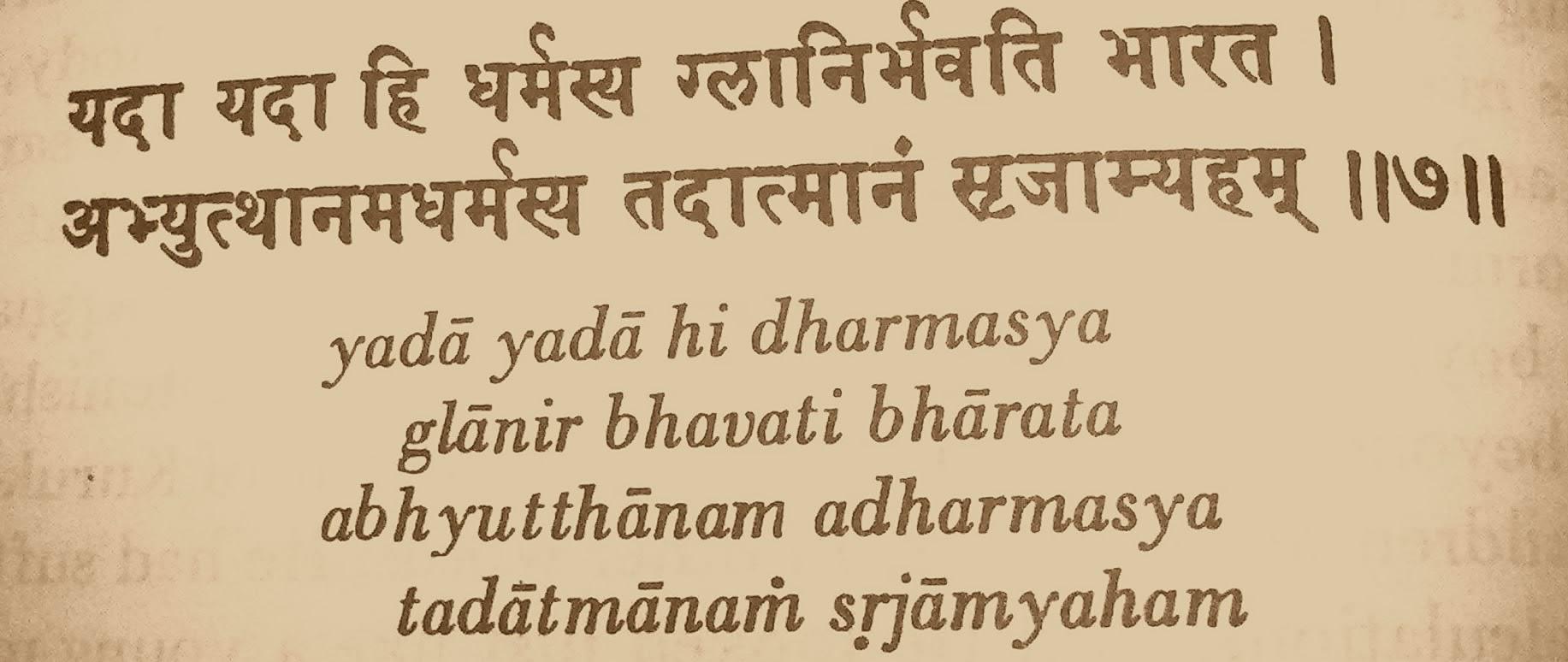There’s something timeless about the verse “Yada yada hi dharmasya glanir bhavati bharata…” from the Bhagavad Gita. If you’ve ever come across this shloka, you’ll know it holds an incredible power to resonate with anyone, regardless of religious beliefs or background. Its message goes beyond the literal, speaking to the universal need for balance, justice, and restoration—concepts that are as relevant today as they were thousands of years ago.
Let’s break it down, not as a religious teaching but as a profound spiritual insight into life and the cycles of human experience.
The Original Sanskrit Verse
Sanskrit:
यदा यदा हि धर्मस्य ग्लानिर्भवति भारत।
अभ्युत्थानमधर्मस्य तदात्मानं सृजाम्यहम्॥
(Chapter 4, Verse 7)
Transliteration:
Yadā yadā hi dharmasya glānir bhavati Bhārata,
Abhyutthānam adharmasya tadātmānaṁ sṛjāmy aham.
Translation:
“Whenever there is a decline in righteousness and a rise in unrighteousness, O Bharata (Arjuna), at that time I manifest myself.”
What Does It Really Mean?
At its core, this verse speaks about balance—something every one of us strives for in life. It’s not just about the grand, cosmic balance but also about the small, personal ones we experience every day.
Think about your own life. There are times when things feel “off.” Maybe you’re overworking yourself and neglecting your health. Or perhaps you’ve been caught in negative patterns, like procrastination or unhealthy relationships. These moments of imbalance are the adharma (unrighteousness) within your personal world. This shloka assures us that when things go too far off course, life itself steps in to restore balance.
Real-Life Relatability: Finding Balance in Chaos
Here’s a story from my own life. A couple of years ago, I hit a point where I felt completely overwhelmed. Work was chaotic, I wasn’t taking care of my health, and my relationships were strained. It felt like I was losing control. That’s when this verse came to mind.
It reminded me that just as chaos builds, so does the opportunity for renewal. Sure enough, I began to make small changes—carving out time for meditation, reconnecting with loved ones, and setting better boundaries. Slowly, balance was restored.
The beauty of this verse lies in its assurance: restoration is inevitable. Whether it’s the universe stepping in to right the wrongs on a grand scale or you taking small steps to realign your life, balance always finds its way.
The Role of “Manifestation”
The shloka says, “I manifest myself” (tadātmānaṁ sṛjāmy aham). Now, you don’t have to interpret this as a deity or divine figure descending to fix things. Spiritually, it could mean that the universe—or your higher self—steps in when imbalance reaches its peak.
Think about it. Haven’t you ever had moments where life seemed to push you toward the right path, even when you didn’t plan it? Maybe it was an unexpected mentor, a serendipitous opportunity, or even a failure that taught you an invaluable lesson. That’s life’s way of manifesting balance, of setting you back on track.

Why Does This Happen?
The verse explains that when dharma (righteousness) declines and adharma rises, action becomes necessary. Dharma, in a spiritual sense, isn’t just about morality or ethics. It’s about living in harmony with the natural flow of life—your true purpose, your values, and the interconnectedness of all things.
When you drift too far from this harmony, the imbalance creates suffering. This suffering, while unpleasant, serves as a wake-up call. It’s like an alarm clock for the soul, urging you to return to your center.
Spiritual Takeaway: The Cycles of Life
The verse “Yada yada hi dharmasya glanir bhavati bharata…” also speaks to the cyclical nature of life. Just as day follows night, balance follows chaos. This cycle is a universal truth, whether it’s in nature, relationships, or personal growth.
For instance, think of a forest fire. It’s destructive, but it clears the way for new growth. Similarly, when life feels like it’s falling apart, it’s often making space for something better. This doesn’t mean we should welcome imbalance or chaos, but it gives us hope that every low point carries within it the seeds of renewal.
Another Key Line: “Paritranaya Sadhunam”
Sanskrit:
परित्राणाय साधूनां विनाशाय च दुष्कृताम्।
धर्मसंस्थापनार्थाय सम्भवामि युगे युगे॥
(Chapter 4, Verse 8)
Translation:
“For the protection of the good, the destruction of the wicked, and the establishment of dharma, I appear in every age.”
This line complements the earlier one by emphasizing the why. It’s about restoration, not punishment. Even in our own lives, when we let go of bad habits or toxic relationships, it’s not about blame or retribution. It’s about creating space for positivity and growth.
Practical Application in Daily Life
- Recognize Imbalance:
Pay attention to areas in your life where things feel out of sync. Maybe it’s your health, work-life balance, or mental well-being. Acknowledge it without judgment. - Take Small Steps:
You don’t have to overhaul your life overnight. Start small. If you’re overworking, set aside 10 minutes for a walk. If relationships are strained, send a thoughtful message to a loved one. - Trust the Process:
Remember, balance is inevitable. Trust that the chaos will pass and that your efforts to restore harmony will bear fruit. - Be Open to Manifestations:
Stay alert for the “manifestations” life offers—a conversation, an idea, or even a failure that pushes you toward growth. These are your signs to realign.
Final Thoughts
The verse “Yada yada hi dharmasya…” isn’t just a philosophical statement; it’s a guide to navigating life’s ups and downs. It reminds us that imbalance is temporary, restoration is natural, and we are never truly alone in this process.
Every time I reflect on this shloka, I’m comforted by its message: no matter how chaotic things seem, there’s a greater order working in the background. And sometimes, all we need to do is trust that order and take one step at a time.
What does this verse mean to you? Have you ever experienced a moment where life seemed to “step in” and restore balance? I’d love to hear your thoughts. Let’s explore this timeless wisdom together.

